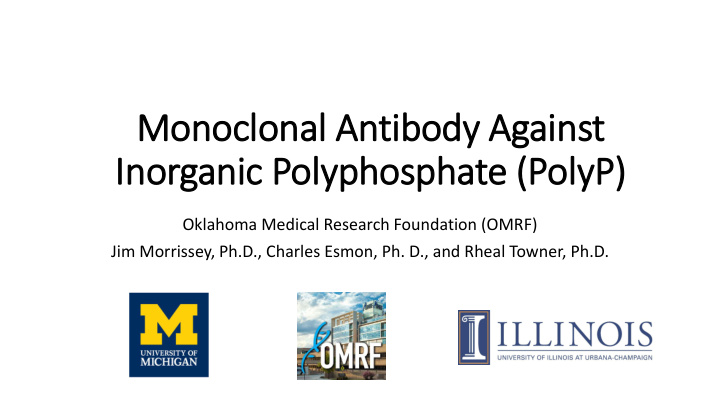



Mon onoc oclonal An Antibody Ag Against Inorgani nic P Polypho phospha phate (Po PolyP) Oklahoma Medical Research Foundation (OMRF) Jim Morrissey, Ph.D., Charles Esmon, Ph. D., and Rheal Towner, Ph.D.
Polyphosph phate (“PolyP”) a are Highly Anioni nic Linear Polymers o of I Inorganic Phosph phate Much of what is known of polyP is from • prokaryotic & eukaryotic organisms. These microorganisms store long chain polyP (> 500-1000+ phosphates) as a source of energy and phosphate during nutrient deprivation. They also appear to use polyP to protect against metal toxicity. PolyP is found in lysosomes, secretory • granules (platelet dense granules), mitochondria, & nuclei of mammalian cells
Chain Length o of P PolyP Determ rmines R Role in t the Host st • Long chain polyP from microorganisms interact with the coagulation cascade at multiple points • Dense granules in platelets of mammalian cells contain polyP of ~60- 100 phosphate units in length. • When platelets are activated in hyperinflammatory conditions, polyP is released in the circulation and play a role in coagulation/thrombosis.
Po PolyP has the Potenti tial to b be e Pathol ologi ogic if f not ot Tightly R Regulated 1. PolyP accelerates factor V activation at factor Xa & thrombin 2 2. Accelerates factor XI back- activation by thrombin 3. Inhibits tissue factor pathway inhibitor ability to inhibit factor Xa 1 4. Longer chain (>400 phosphates) 4 1 enhance fibrin polymerization 3 Adapted from Smith & Morrissey Curr Opin Hematol 2014, 21: 388-394
Anti-polyP Antibo body P Pre-Trea eatmen ent Improves es Survi vival in a Hy Hyper erinflammator ory Challenge Preliminary studies show that anti-polyP antibodies were protective in a hyperinflammatory LPS challenge model in mice. % Survival - Control LPS was premixed with anti-polyP antibodies (pp2071 & pp2059) or isotype control (mIgG1k1750) then delivered i.v. retroorbitally Days
Anti-polyP An Antibodies as a Potential Therapy in Hy Hyper erinflammator ory Conditi tions • We have isolated multiple anti-polyP antibodies that bind to polyPs of varying lengths (U.S. Nat’l stage PCT priority date of 8/21/14; jointly owned rights of U. of IL & OMRF; OMRF is lead for prosecution & licensing) • These antibodies have the potential to alleviate inflammatory & thrombotic complications due to platelet activation & polyP release • There are multiple acute conditions where activated platelets and/or coagulopathies are implicated. • Such conditions include Acute Respiratory Distress Syndrome (“ARDS”), Acute Pancreatitis, and Ischemia Reperfusion Injury (“IRI”) • We used IRI as a proof of concept for our preliminary data
Anti-polyP Antibo body T Treatment Protects Against IRI I (MRI) I) A rat model of IRI is used where the left kidney undergoes 30 minutes of ischemia followed by an hour of reperfusion before magnetic resonance imaging (“MRI”) A. MRI of control rat (untreated) showing damage in upper cortical & medullary regions (arrow) of ischemic kidney contralateral kidney serves as internal control Other qualitative data (not shown) from MRI reveal anti-polyP B. MRI of rat pretreated with anti-polyP antibody treated kidneys maintain near normal levels of perfusion antibody i.v . (tail vein) 30 minutes prior compared to ischemic controls. Also kidney metabolites that are to ischemia. elevated in IRI are lower in the anti-polyP treated kidneys
Pol olyP Antib tibodies & & Trea eatment of of Fi Fibrosis is Releasates were generated by treating human platelets (at 1 x 109/mL in Tyrode’s buffer) with Thrombin Receptor-Activating Peptide (TRAP). Platelets were removed by centrifugation, and the supernatant was collected (termed “platelet releasate ”). The protein concentration in releasates was determined using a NanoDrop spectrophotometer, and the releasates were subsequently diluted in Tryode’s buffer to a protein concentration of 300 μg /ml. Some of the releasates were heated at 95 °C for 30 minutes to inactivate any protein activity, then cooled to room temperature (polyphosphate is heat-resistant, and many control experiments have shown that its activity is unaltered by this heat treatment). Some of the heated or non-heated releasates were subsequently treated with 40 μg /ml of a recombinant polyphosphate-degrading enzyme, yeast exo-polyphosphatase (ScPPX1), for 1 hour at 37 °C. The variously treated releasates, or Tyrode’s buffer control, were diluted twentyfold into DMEM containing 1.5% bovine calf serum and incubated with subconfluent NIH-3T3 fibroblasts for 48 hours. Cells were subsequently fixed, permeabilized and stained for α -SMA actin and imaged using a confocal microscope. Fluorescent integrated density was determined using ImageJ, and cells were scored for α -SMA localized to actin stress fibers. All values are mean ± SEM, n = 3 with a minimum of 25 cells analyzed for each individual experiment and condition. * indicates p < 0.05, ** p <0.01 compared to the no-polyphosphate control (unpaired t-tests).
Near F r Futur ure (14 14-18 18 Months hs) P Plan • Determine a therapeutic window for anti-polyP antibody treatment i.e. treatment post injury • Confirm that anti-polyP antibodies do not increase bleeding • Follow up testing on in vivo inflammation & coagulation biomarkers • Biodistribution & PK/Clearance Studies • Antibody Characterization and Binding Assay • Antibody Lead Selection & Humanization • Animal Studies: ARDS/ALI, Acute Pancreatitis & Fibrosis (liver/lung) • Total Estimated Cost of Studies: ~$750,000 + Cost of mAb humanization
Recommend
More recommend